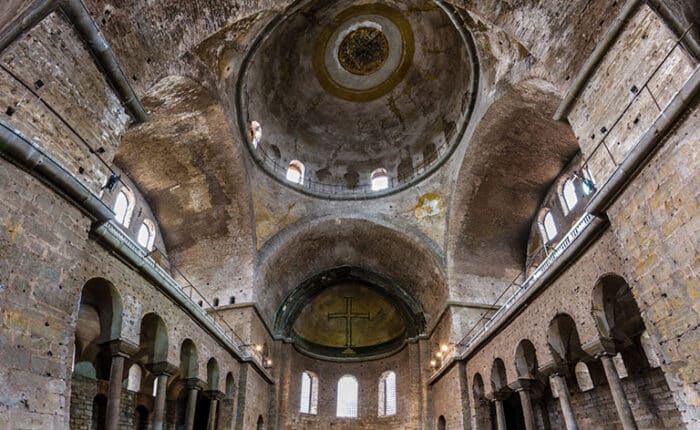The Hagia Irene has come a long way before becoming the structure we see and love today. Long before it was a church, the Hagia Irene was a small temple dedicated to Venus/Aphrodite (the goddess of love and beauty). As Christianity spread into the region, the temple became a small church.
When Constantine moved the seat of the Roman Empire east to Constantinople (Istanbul), the small church was renovated into the Hagia Irene (Aya Irini in Turkish). From then on, the church has endured a couple of unfortunate events:
After the earthquake, the Aya Irini was rebuilt by Constantine V using a simple architectural plan with little decorations. During the Ottoman Occupation, the church served as an armory before it was converted into a Military Museum in the 19th century and later an Archeology Museum.
Because it was restored several times by different empires, the church’s architectural features are quite complicated. When the empire Constantine first completed the Hagia Irene in 337, it was a three-nave basilica. During the Justinian era after the fire of 532, the Hagia Irene was reconstructed as a domed basilica. After the destruction by an earthquake (740), the empire Constantine V made several key changes to the structure that turned it into a cross-domed basilica.
Today, the Aya Irini consists of a narthex, an atrium, an abscissa, and three-nave naos. The building materials mainly consist of thin red bricks and mortar.
Before the earthquake and consequent reconstruction by Constantine V, the Hagia Irene is believed to have had rich decorations lining the interior. This was also around the time of the Byzantine Iconoclasm when Emperor Leo III banned the use of religious images and symbols in all churches. The ban destroyed mosaics and frescoes in churches, and hence, the Hagia Irene was reconstructed in a simpler architectural plan.
Nevertheless, the bema arch and the apse semi-dome are still covered with mosaics. These are rare examples of iconoclastic art from the Byzantine period and date back to about the 8th century. An iconic mosaic in the museum is one of a cross in the apse semi-dome. The cross outlined in black and has a gold background, dates back to the reconstruction by empire Constantine V.
There are also inscriptions of bible verses on the inner and outer sides of the bema arch.
The Aya Irini is one of the few Byzantine churches to have never been converted into a mosque after the Ottoman occupation of Constantinople. Instead, it was used to store weapons and spoils of war until it became a military museum and later an archeology museum.
Today, when the building is not awing visitors with its rich history, it serves as a concert hall for classical music thanks to its brilliant acoustic. It has hosted many concerts of the Istanbul International Music Festival and, in 2000, an impressive show by the Turkish designer Faruk Sarac that exhibited robes inspired by Ottoman Empires.



The church of Hagia Eirene has been open to the public since 2014. Since it is not as glamorous or famous as the Hagia Sophia, it is one of Istanbul’s hidden gems. Therefore, it is a spot where you don’t have to navigate through crowds of tourists, and thus, exploring the historic building is a relatively comfortable experience.
Getting to the Aya Irini Museum is quite easy; you head towards Topkapi Palace in Sultanahmet, where the church sits in the palace’s first courtyard. The museum is open from 9 am to 5 pm every day, apart from Tuesday.
Although the museum sits inside the Topkapi Palace, you cannot visit it with your Topkapi Palace Museum Ticket; you need a separate ticket for the Hagia Irene. To avoid all these, you can always book a guided tour of the museum. At the entrance, children will be asked to present their passports as proof of age.
Inside, the Hagia Irene does not promise the glory and splendor that has made the Hagia Sophia famous. Its simplistic architecture, iconoclastic mosaics, and rich history make it a bizarre site to explore.
For visitors who want to enjoy the museum’s wonderful acoustics, the best time to visit the Hagia Irene is during the Istanbul Music Festival. The three-week concert treats tourists and locals alike to some of the best music and instrumentals.
Istanbul is among the world’s most comprehensive and most boundless cultural and historical cities. Hence, Hagia Irene is environed by many other interesting places and historical sites you can cover during the visit. These include the breathtaking Hagia Sophia, the fascinating cisterns, the gorgeous Blue Mosque, and so much more.